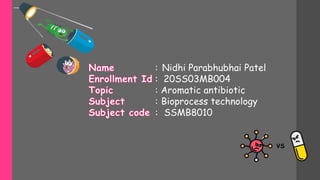
Aromatic antibiotics
- 1. VS Nidhi Parabhubhai Patel 20SS03MB004 Aromatic antibiotic Bioprocess technology SSMB8010 : : : : :
- 2. VS
- 3. “The antibiotics with aromatic rings in their structure are regarded as aromatic antibiotics.”
- 4. In a strict since, all the antibiotics containing aromatic nuclei should be considered in this group. However, most authors prefer to treat the three important antibiotics namely chloramphenicol, griseofulvin and novobiocin in the category of aromatic antibiotics, and the same is done in this book also.
- 5. Chloramphenicol Chloramphenicol is a broad spectrum antibiotic that can act against Gram-positive and Gram- negative bacteria, besides rickettsia, actinomycetes and chlamydia. However, administration of chloramphenicol is associated with side effects, the most significant being damage to bone-marrow. As such, chloramphenicol is treated as a reserve antibiotic and selectively used. Chloramphenicol binds to 50S ribosomal subunit and blocks (peptidyltransferase reaction) protein biosynthesis.
- 7. Production of chloramphenicol Chloramphenicol can be produced by Streptomyces venezuelae and S. omiyanesis. However, chemical synthesis is mostly preferred for the commercial production of chloramphenicol. Chloramphenicol is lipid- soluble, allowing it to diffuse through the bacterial cell membrane. It then reversibly binds to the L16 protein of the 50S subunit of bacterial ribosomes, where transfer of amino acids to growing peptide chains is prevented thus inhibiting peptide bond formation and subsequent protein synthesis.
- 8. Uses of Chloramphanical Treat eye infection Sometimes ear infection
- 9. Griseofulvin Griseofulvin is an antibiotic that acts specifically on fungi with chitinous cell walls. It is used in the treatment of various fungal skin infections. Further, griseofulvin is also employed in the treatment of plant diseases caused by Biotrytis and Alternaria solani. Although the exact mechanism of action of griseofulvin is not known, it is believed that chitin biosynthesis is adversely affected.
- 10. Griseofulvin
- 11. Commercial production of griseofulvin is carried out by employing Penicillium patulum. The chemical synthesis is less frequently used due to high cost. The fermentation is carried out by an aerobic submerged process with a glucose rich medium. Nitrogen is supplied by sodium nitrate. The optimal conditions for fermentation are— 1) temperature 23-26°C 2) pH 6.8-7.3 3) aeration 0.8-1 vvm 4) period 7-10 days Production of Griseofulvin
- 12. Manufacturing of Griseofulvin Preparation of Media Medium: Czapek Dox Medium Chemicals: Glucose – 0.5% Sodium nitrate – 0.2% Potassium hydrogen phosphate – 0.1% Magnesium sulphate - 7𝑯𝟐𝑶 0.05%
- 13. Steps involved in the manufacturing process Pre treatment of fermentation broth Fermentation Filtration Extraction Decolorization Isolation and separation Precipitation and purification 1 2 3 4 5 6 7
- 14. 1.Fermentation The pH of Czapek-Dox medium was adjusted between 6.0-7.2. The medium was dispensed in the fermenter . The fresh sample of mycelial suspension of fungus Peccillium griseofulvum from the fresh slope on raper steep agar (Czapek-Dox medium + corn steep+ agar) was obtained. The solution was autoclaved for 200 minutes at 120°C at 15lbs pressure and fermented for 14 days at 24°C.
- 15. 2.Pretraetment of fermentation broth The broth is heated above 60°C for 20- 30minutes. After heating, sufficient coagulation of material occurs to produce a valuable improvement in separation characteristics of the broth. The period of heating may be short, 5-10 minutes at 80°C having been found to provide a satisfactory increase in filtration rate.
- 16. 3.Filtration Drum covered with diatomaceous earth matter and allowed to rotate under vacuum with half immersed in the slurry tank. Small amount of coagulation agent added to broth and pumped into the slurry tank. As drum rotates in the slurry tank under vacuum thin layer of coagulated particles adhere to drum. The layer thickens to from cake. As the cake portion in the drum comes to the upper region which is not immersed in the liquid it is washed with water and dewatered immediately by blowing air over it. Then before the dried portion is again immersed into the liquid it is cut off from drum by knife.
- 17. 4.Extraction Griseofulvin is extracted in the cold acetone when it is used as an extraction agent. The extractions with the cold acetone may be carried out with the efficiencies between 75-96% or even up to 99.5%. the quantity of the solvent used in the extraction at large scale production should be kept minimum. The volume of acetone should be 3-5 times of the mycelial felt.
- 18. 5.Decolorization The color of the extract can be improved by the addition of calcium hydroxide usually 2.5-50 g/liter preferably 5- 30 g/liter. The pH of the extract should be above 10. It can be neutralize by the removal of lime or by using mineral acid.
- 19. 6.Isolation and separation The impurities or waxy substances are removed by washing the extract with a solvent in which extract is immiscible and also griseofulvin is insoluble. Hydrocarbon solvents, generally aliphatic hydrocarbons such as hexane or petroleum containing a high portion of hexane are in general suitable for this step.
- 20. Griseofulvin can be precipitated from the solvent extract in various ways. One of the method is using the liquid solvent in which griseofulvin is substantially insoluble. Griseofulvin non-solvent is preferably water. The alkaline water is more effective for the removal of colored impurities present in the crystals of the griseofulvin. 7.Precipitation and Purification
- 21. 7.Precipitation and Purification Water is made alkaline with ammonia or an alkali metal carbonate or alkali metal hydroxide. The suitable pH is about 8.5. The purity of the precipitate is generally improved by washing with a solvent for the small quantities of impurities remaining. The suitable washing media are dry or wet acetone, a lower alkanol for example methanol or butanol. Marked purification is obtained with the use of methanol for this step.
- 22. Uses of Griseofulvin Treat skin infection Fungal infection Jockitch Athlete’s foot Ringworm On scalp On fingernails On toenails
- 23. Thank you